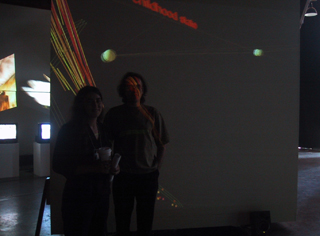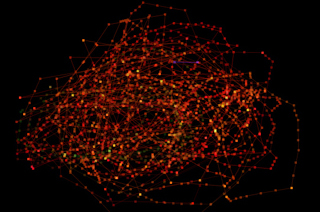Electronic Sphere
Aleksandra Dulic: interactive animation, insatllation
Kenneth Newby: music composition, insatllation
Presented at: New Forms Media Festival, 2003.
Electronic Sphere presents an articulation of three-dimensional form composed of independent voices constrained by the geometry of the sphere.The inner melody of the Electronic Sphere is the mathematics of the sphere, along which the diverse voices, the elementary points, are singing the spatial melody. The random walk of each voice can traverse the sphere, as well as deviate from the surface by moving inwards and outwards of the geometry of the sphere
The three-dimensional Electronic Sphere is articulated through time by multiple elementary fragments that are constituted by a point in space. The points in space live a trace of their random walk along the invisible surface of the sphere.
Electronic Sphere is the exploration of the articulation of form using multiple sources that are correlated by the geometry of the sphere. Every voice is a drawing process that has some parameters that can be manipulated. In that sense this object, according to Row’s second classification, is an instrument paradigm. The player can specify the quality of line (straight or curved), the color range, the individual voice, and the deviation from surface of sphere. Every parameter for voice can be independently manipulated, so that each voice is a unique variation of the drawing process. The unifying element is that all the voices are constrained in some relationship to the surface of the sphere. The mathematics of the sphere is the ‘inner melody’ of the work.


For the presentation of Electronic Sphere in the Western Front, the drawing process based on the geometry of the sphere was extended to include the inner space of the sphere composed by participants drawing in the real space, and an audio component composed by Mark Brady.
The audiences at the Western Front were able to generate the sound and image by drawing in the three-dimensional virtual space of Electronic sphere. Robb Lovel's machine vision system Eyes was set to track movements in the physical space of the gallery. Two cameras were positioned, one top view and one side view, in order to track participants’ gestures. Gestures were isolated by a light source,the movement of which was tracked by the system, and the traces of gestures were made visible in the virtual space by the electronic-sphere drawing process, and amplified by sound generated in response to the gesture. The Electronic Sphere acts as an audio/visual instrument played by the audience in the space.